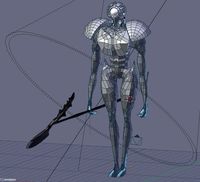Thingiverse

Pulsars scaled one in 500 thousand
by Thingiverse
Last crawled date: 4 years, 3 months ago
This post is intended to show pulsar solid body approximate in their size and shape scaled one in 200 thousand and one in 500 thousand. In these scales, you can compare them with small asteroids and moons. This is because pulsars are mostly neutron stars, remnant of massive stars supernovae, more massive than the Sun, compacted to a sphere of a few kilometers in diameter. The word "pulsar" derive from "pulsated star", because their radiation is seen from Earth modulated by pulses. This is because they are spining at high speeds, and their magnetic field distorts their emmited radiation every revolution (several times per second). At these speeds it is spected that the star oblate because of the centrifugal force. To make this oblateness I used MATLAB R2016a with the formula of the Maclaurin and Jacobi ellipsoid considering the neutron star as if has homogeneus density. This could be true for some neutron stars, but a real composition is difficult to known exactly for every case, and it's troubling to simulate, so take the shape of the models in this post as hypothetical. In some of these, the mass and/or the size of the pulsar is unknown. For those cases, I arbitrary choosed a mean mass of 1.4 solar masses, and a mean radius of 10 km. Only for the recently described PSR J0030+045, by Riley (2019), it is ploted with some surface features, which are luminous spots, represented as depressions, only for demostrative purpose.
The file's names explained: name_1_x_10_y.stl is 1 : x * 10y. So _1_6_10_7 is 1:600000000 or one in 60 million.
The file's names explained: name_1_x_10_y.stl is 1 : x * 10y. So _1_6_10_7 is 1:600000000 or one in 60 million.
Similar models
thingiverse
free

Pan, Daphnis and Atlas scaled one in 500 thousand
...500 thousand.
the file's names explained: name_1_x_10_y.stl is 1 : x * 10y. so _1_6_10_7 is 1:600000000 or one in 60 million.
sketchfab
$7

A highly magnetized rotating neutron star
...beam of emission points toward the observer. this behavior, similar to that of a lighthouse, is at the origin...
3dwarehouse
free

SketchyPhysics : Universe : Pulsar
...sketchyphysics : universe : pulsar
3dwarehouse
a type of neutron star. read about pulsars on wikipedia.
thingiverse
free

Exoplanets scaled one in 120 million
...biggest ones.
the file's names explained: name_1_x_10_y.stl is 1 : x * 10y. so _1_6_10_7 is 1:600000000 or one in 60 million.
grabcad
free

Beryllium atom model with nearly impossible to find electrons
...re tree and select the origin of the electron or select the sketch of the electron and zoom/scroll into the electron to see it.
thingiverse
free

1:24 scale stage lighting mover based upon a MAC 500 by Ronnskull
...to fit. this technique allows for a better cylinder shape when printing this small. if you print one (or more) send me some pics
cg_trader
$2

Earth
...mercury and venus and before mars. ... earth is an oblate spheroid. this means it is spherical in shape, but not perfectly round.
thingiverse
free

Speed Shape for paint tests by PandaProps
...the fender lines to add some variety and detail opportunities to test your paint work.
scale it to whatever size you need.
enjoy!
3dwarehouse
free

The Halo #1
...rning!!!: this model is massive (and i mean massive) !!!!! # #1 #basic #games #halo #halo2 #massive #ring #scifi #space #the_halo
3dwarehouse
free

Approx. Scale Model of a Proton, Neutron, and Electrion
...he same size, at 1.6 femtometers (1.6 meters in the model). #atomic_model #atoms #electron #neutron #proton #relative_size #scale
Pulsars
3ddd
free

Marchetti Pulsar
...marchetti pulsar
3ddd
marchetti , pulsar
lamp ceiling marchetti pulsar, diameter 40cm.
turbosquid
$8

pulsar
... available on turbo squid, the world's leading provider of digital 3d models for visualization, films, television, and games.
3d_export
$97

pulsar 125
...pulsar 125
3dexport
pulsar 125 is an indian bike form bajaj automobiles https://youtu.be/kc41gfxkiyk
turbosquid
$10

fire detector pulsar
... available on turbo squid, the world's leading provider of digital 3d models for visualization, films, television, and games.
3d_export
$99

Nissan Pulsar 2015 3D Model
... pulsar 2015 3d model
3dexport
2014 japan 2015 2016 hatchback nissan 2017 pulsar
nissan pulsar 2015 3d model squir 84939 3dexport
cg_studio
$99

Nissan Pulsar 20153d model
...io
.3ds .c4d .fbx .lwo .max .obj - nissan pulsar 2015 3d model, royalty free license available, instant download after purchase.
3d_ocean
$89

Nissan Pulsar (Sentra) 2014
...y, in real units of measurement, qualitatively and maximally close to the original. model formats: - *.max (3ds max 2008 scanl...
turbosquid
$45

Eaton Pulsar STS 16
...download as sldas, 3dm, lwo, stl, 3ds, obj, dae, fbx, and ige on turbosquid: 3d models for games, architecture, videos. (1575432)
3d_export
$99

Nissan Pulsar Sentra 2014 3D Model
...ra sylphy nb17 2012 2013 2014 2015 4-door sedan saloon japan japanese
nissan pulsar sentra 2014 3d model humster3d 81684 3dexport
cg_studio
$99

Nissan Pulsar (Sentra) 20143d model
... .fbx .lwo .max .mb .obj - nissan pulsar (sentra) 2014 3d model, royalty free license available, instant download after purchase.
Thousand
turbosquid
$28

Thousand Sunny
... available on turbo squid, the world's leading provider of digital 3d models for visualization, films, television, and games.
turbosquid
free

Thousand Dollar
... available on turbo squid, the world's leading provider of digital 3d models for visualization, films, television, and games.
3d_export
$65

Thousands of troops
...thousands of troops
3dexport
simple rendering of the scene file
turbosquid
$5

Voxelart Thousand Sunny
...lty free 3d model voxelart thousand sunny for download as obj on turbosquid: 3d models for games, architecture, videos. (1262032)
3d_export
$5

umbrella of a thousand probabilities
... of a thousand probabilities
3dexport
model of the game character of the protagonist of the anime "avatar of the king"
3d_export
$18

9 thousand years of flat peach tree
...at peach tree
3dexport
executed in 3d max 2014<br>all textures and materials needed for the rendering found in the archive
turbosquid
$12

ronze Tripod furnace incense round tripod thousand Tripod Sculpture Artifacts
...pod thousand tripod sculpture artifacts for download as max on turbosquid: 3d models for games, architecture, videos. (1713294)
3d_export
$199

thousand oaks city california 40km
...t;1. suitable for games, games, education, architecture etc.<br>2. mainly used for town and urban planning, real estate etc
3ddd
$1

Fantasia Lamp
...or waiting rooms. fantasia - the lamp of a thousand lights and a thousand...
3d_export
$19

beautiful girl
...girl in modern clothes. detailed grid - about 100 thousand ...
500
turbosquid
$50

500
...500
turbosquid
royalty free 3d model 500 for download as on turbosquid: 3d models for games, architecture, videos. (1578463)
3d_export
$5

md 500
...md 500
3dexport
the md helicopters md 500 series is an american family of light utility civilian and military.
3d_export
$17

Helicopters MD 500
...helicopters md 500
3dexport
helicopters md 500
3ddd
$1

dreambox dm-500
...dreambox dm-500
3ddd
dreambox dm-500
3ddd
$1

CX-500 Custom
...cx-500 custom
3ddd
honda , мотоцикл
cx-500 custom
3d_export
$8

tnk 500
...tnk 500
3dexport
office chair
turbosquid
$35

500 euro
...alty free 3d model 500 euro for download as max, obj, and stl on turbosquid: 3d models for games, architecture, videos. (1223365)
turbosquid
$20

FIAT 500
...yalty free 3d model fiat 500 for download as ma, obj, and fbx on turbosquid: 3d models for games, architecture, videos. (1490818)
3ddd
$1

500 Fifth Avenue
...500 fifth avenue
3ddd
статуэтка
статуэтка 500 fifth avenue, new york
turbosquid
$59

MSP 500
... available on turbo squid, the world's leading provider of digital 3d models for visualization, films, television, and games.
Scaled
turbosquid
$20

Weight scale or Bathroom Scale
...ght scale or bathroom scale for download as max, fbx, and obj on turbosquid: 3d models for games, architecture, videos. (1664576)
turbosquid
$19

Scale
...e
turbosquid
royalty free 3d model scale for download as fbx on turbosquid: 3d models for games, architecture, videos. (1411722)
turbosquid
$5

Scales
...s
turbosquid
royalty free 3d model scales for download as ma on turbosquid: 3d models for games, architecture, videos. (1393439)
turbosquid
$40

Scale
... available on turbo squid, the world's leading provider of digital 3d models for visualization, films, television, and games.
turbosquid
$17

Scales
... available on turbo squid, the world's leading provider of digital 3d models for visualization, films, television, and games.
turbosquid
$12

Scale
... available on turbo squid, the world's leading provider of digital 3d models for visualization, films, television, and games.
turbosquid
free

Scale
... available on turbo squid, the world's leading provider of digital 3d models for visualization, films, television, and games.
3d_export
$7

of scales
...s have a flat point of support. the samples are rendered in the standard cinema 4d renderer. enjoy your use and creative success.
3d_export
$5

scale knob
...scale knob
3dexport
scale knob
3d_export
$20

cartoon weight scale or bathroom scale
...cartoon weight scale or bathroom scale
3dexport
texture size:512px number of texture:1 texture format: png
One
turbosquid
$2

one plus one
... available on turbo squid, the world's leading provider of digital 3d models for visualization, films, television, and games.
3ddd
$1

One
...one
3ddd
стул
офисный стул one
3ddd
free

one
...
palazetti one ,http://palazzetti.ca/index.php/component/virtuemart/seating/armchairs-lounges/one-chair-detail?itemid=0
turbosquid
$35

One A
... available on turbo squid, the world's leading provider of digital 3d models for visualization, films, television, and games.
turbosquid
free

One
... available on turbo squid, the world's leading provider of digital 3d models for visualization, films, television, and games.
3ddd
$1

Стул One
...стул one
3ddd
one , magis
кресло magis s.p.a , one
3ddd
$1

Стул One
...стул one
3ddd
one , magis
кресло one chair (4star), magis s.p.a.
3d_export
$20

xbox one
...xbox one
3dexport
xbox one
3ddd
$1

xbox one
... консоль , джойстик
xbox one + kinect + gamepad
3ddd
free

One
...nstantin grcic
артикул ct-284 (cosmorelax.ru)
размер l36xw41xh82.5, sh 77cm
цвет черный, красный
материал алюминий
вес 2,5 кг
